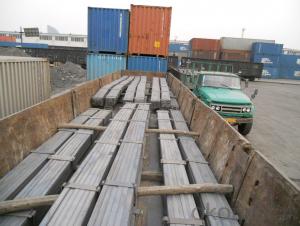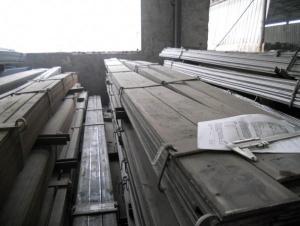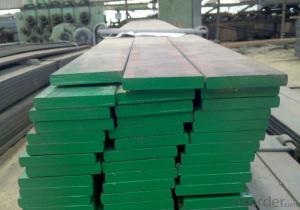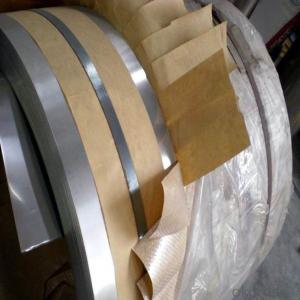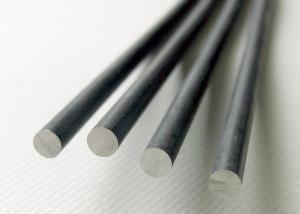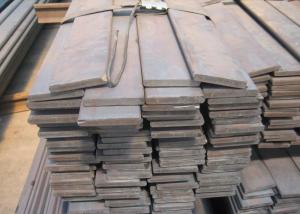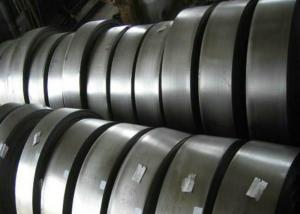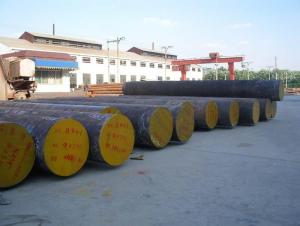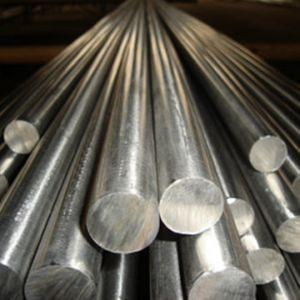Hot Rolled Spring Steel Flat Bar
- Loading Port:
- China Main Port
- Payment Terms:
- TT or LC
- Min Order Qty:
- -
- Supply Capability:
- -
OKorder Service Pledge
OKorder Financial Service
You Might Also Like
Product Description:
OKorder is offering high quality Steel Flat Bar at great prices with worldwide shipping. Our supplier is a world-class manufacturer of steel, with our products utilized the world over. OKorder annually supplies products to European, North American and Asian markets. We provide quotations within 24 hours of receiving an inquiry and guarantee competitive prices.
Product Applications:
Steel Flat Bar are ideal for structural applications and are widely used in the construction of buildings and bridges, and the manufacturing, petrochemical, and transportation industries.
Product Advantages:
OKorder's Steel Flat Bar are durable, strong, and resist corrosion.
Main Product Features:
· Premium quality
· Prompt delivery & seaworthy packing (30 days after receiving deposit)
· Corrosion resistance
· Can be recycled and reused
· Mill test certification
· Professional Service
· Competitive pricing
Product Specifications:
Commodity: Mild Steel Flat Bar
Standard: GB;JIS
Material: Q195-235;SS400
Origin place: China
Thickness: 3mm-30mm
Width:20mm-200mm
Length: Max 12m
Certification: SGS/BV


Usage/Applications of Steel Flat Bar
Widely used for construction, Machinery manufacturing, Iron tower steel structure, Shipbuilding; Steel grating, Staircase, Bridge, Viaduct, Railway spare parts, Boilers making etc.
Packaging & Delivery of Mild Steel Flat Bar
Packaging Details: The Mild Steel Flat Bars are packed in bundles and loaded in 20 feet/40 feet container, or shipped by bulk cargo ,also we can do as customer's requirements.
Delivery Details:30~45 days upon the receipt of buyer payment by T.T. or L/C.
Production Flow of Steel Flat Bar
The Mild steel flat bar is made through three processes:
1.Feeding the material: Feeding the row material (the steel plate) to Slitting Line.
2.Slitting:The steel plate would be slitted into expected width by lengthways cutter.
3. Leveled and cutting: The plat bar would be ground into level by the grinder and then cut into required length
Payment:
-Invoicing on theoretical weight or actual weight as customer’s request.
-Regular terms of payment:
1, 30% payment in advance, the remaining balance (70% payment) against the copy of B/L.
2, 30% payment in advance, the remaining balance (70% L/C) against the copy of B/L.
3, Negotiable.
FAQ:
Q1: Why buy Materials & Equipment from OKorder.com?
A1: All products offered byOKorder.com are carefully selected from China's most reliable manufacturing enterprises. Through its ISO certifications, OKorder.com adheres to the highest standards and a commitment to supply chain safety and customer satisfaction.
Q2: How do we guarantee the quality of our products?
A2: We have established an advanced quality management system which conducts strict quality tests at every step, from raw materials to the final product. At the same time, we provide extensive follow-up service assurances as required.
Q3: How soon can we receive the product after purchase?
A3: Within three days of placing an order, we will begin production. The specific shipping date is dependent upon international and government factors, but is typically 7 to 10 workdays.
- Q: What is the purpose of annealing in special steel production?
- The purpose of annealing in special steel production is to improve the mechanical properties and overall quality of the steel. Annealing is a heat treatment process in which the steel is heated to a specific temperature and then slowly cooled, typically in a controlled atmosphere. This process helps to relieve any internal stresses or strains that may have developed during previous manufacturing processes such as rolling or forging. During annealing, the steel's microstructure undergoes changes, resulting in a more refined and homogeneous material. The process allows for the redistribution of atoms, which helps to eliminate defects, improve grain structure, and enhance the steel's toughness, ductility, and machinability. Annealing also helps to reduce the hardness of the steel, making it easier to work with and shape. It can also improve the steel's resistance to cracking and enhance its resistance to corrosion or other environmental factors. Additionally, annealing can help to achieve desired physical properties such as increased hardness or improved magnetic properties in certain special steel alloys. Overall, the purpose of annealing in special steel production is to optimize the steel's properties and ensure it meets the specific requirements of its intended application, whether it be in industries such as automotive, aerospace, or manufacturing.
- Q: What are the different surface treatment methods used for special steel?
- Some of the surface treatment methods used for special steel include electroplating, hot-dip galvanizing, powder coating, and nitriding.
- Q: What are the different types of tool steels used in special steel?
- Some of the different types of tool steels used in special steel include high-speed steels, cold work steels, hot work steels, and plastic mold steels. Each type of tool steel is designed to have specific properties that make it suitable for different applications, such as cutting, shaping, or molding materials.
- Q: How does special steel perform in high-temperature applications?
- Special steel performs exceptionally well in high-temperature applications. It has excellent heat resistance and can withstand extreme heat without losing its strength or shape. This makes it highly suitable for use in industries such as aerospace, power generation, and automotive, where it is exposed to high temperatures and thermal stress. Additionally, special steel exhibits good oxidation and corrosion resistance, ensuring its durability and reliability in these demanding conditions.
- Q: What are the different forging techniques for special steel parts?
- There are several different forging techniques that can be used to produce special steel parts, depending on the desired shape, size, and properties of the final product. Some of the commonly used forging techniques for special steel parts include: 1. Open-die forging: This technique involves shaping the metal between flat dies or anvils. It is typically used for simpler shapes and allows for flexibility in producing a wide range of sizes. 2. Closed-die forging: Also known as impression-die forging, this technique involves shaping the metal within a closed die, which contains the desired shape and allows for higher precision. Closed-die forging is commonly used for producing complex and intricate shapes. 3. Upset forging: In this technique, the metal is compressed and shaped by applying pressure to the ends of the workpiece. Upset forging is often used to create parts with increased diameter or reduced length, such as bolts and nails. 4. Ring rolling: This technique involves shaping a cylindrical workpiece by applying pressure from rotating rolls. It is commonly used for producing seamless rings with enhanced strength and durability, such as gears, bearings, and flanges. 5. Isothermal forging: This technique involves forging the metal at a constant temperature, usually within a specially designed furnace. Isothermal forging allows for precise control over the metallurgical properties of the final product, resulting in improved mechanical properties and reduced residual stress. 6. Precision forging: Also known as near-net-shape forging, precision forging uses specially designed dies to produce parts with minimal finishing operations. It is commonly used for complex shapes and high-volume production, ensuring cost-effectiveness and dimensional accuracy. 7. Press forging: In this technique, the metal is shaped by applying pressure through a mechanical or hydraulic press. Press forging allows for precise control over the forging process and is often used for producing high-strength, large-sized components. Each of these forging techniques offers unique advantages and is suitable for different applications. The selection of the appropriate forging technique for special steel parts depends on factors such as the desired shape, size, strength, and cost-effectiveness of the final product.
- Q: What are the factors that affect the mechanical properties of special steel?
- The mechanical properties of special steel are affected by several factors. Some of the key factors include the chemical composition of the steel, the heat treatment process, the presence of impurities or alloying elements, the microstructure of the steel, and the manufacturing process used. These factors can greatly influence the steel's strength, hardness, toughness, ductility, and corrosion resistance.
- Q: What are the different casting grades of special steel?
- Special steel is a type of steel that is specially designed to possess specific exceptional properties, making it suitable for specialized applications. Within the realm of special steel, various casting grades are available, each with its own unique characteristics and uses. One commonly used casting grade of special steel is stainless steel, which contains a high percentage of chromium, giving it excellent corrosion resistance properties. It is extensively utilized in applications where resistance to oxidation, acids, and other corrosive elements is crucial, such as in the manufacturing of kitchen utensils, medical instruments, and chemical processing equipment. Another casting grade of special steel is tool steel, specifically formulated to exhibit exceptional hardness, wear resistance, and toughness. It is commonly employed in the production of cutting tools, dies, molds, and other tools that require high strength and durability. High-speed steel is an important casting grade of special steel, known for its exceptional heat resistance and ability to maintain hardness even at high temperatures. It finds widespread use in the production of cutting tools like drills, taps, and milling cutters, where the material is exposed to high temperatures generated during the cutting process. Moreover, there are casting grades of special steel specifically designed for use in extreme temperature environments. These grades, such as heat-resistant steel, are formulated to retain their strength and integrity even at elevated temperatures. Heat-resistant steel is commonly used in applications such as furnace components, exhaust systems, and gas turbines. In conclusion, the various casting grades of special steel offer a wide range of properties and applications. Stainless steel provides excellent corrosion resistance, tool steel offers exceptional hardness and toughness, high-speed steel is known for its heat resistance, and heat-resistant steel is designed to withstand extreme temperatures. These grades of special steel play a crucial role in various industries where specific applications require exceptional properties.
- Q: What are the challenges in machining special steel with high hardness?
- One of the main challenges in machining special steel with high hardness is the increased tool wear. Due to the hardness of the steel, the cutting tools used in the machining process wear out more quickly, leading to shorter tool life and increased tool replacement costs. Additionally, the high hardness of the steel makes it more difficult to achieve accurate and precise machining, as it requires higher cutting forces and can cause issues such as tool chipping or breakage. Specialized machining techniques and tools are often required to overcome these challenges and ensure successful machining of high hardness steel.
- Q: What are the different test methods used to evaluate special steel?
- There are several test methods used to evaluate special steel, including mechanical tests such as tensile strength, hardness, impact toughness, and fatigue strength testing. Chemical analysis is also essential to determine the composition of the steel, while microstructure examination allows for the assessment of grain size, inclusion content, and overall quality. Additionally, non-destructive testing methods like ultrasonic testing, magnetic particle inspection, and dye penetrant testing are employed to detect any surface or subsurface defects in the steel. These various test methods provide comprehensive information about the mechanical properties, chemical composition, microstructure, and overall quality of special steel.
- Q: What are the different methods of hardening special steel?
- There exist various techniques for strengthening special steel, each possessing its own merits and suitable applications. 1. Quenching: A widely employed approach for steel hardening, it entails heating the steel to a critical temperature and rapidly cooling it in a quenching medium such as oil, water, or air. This rapid cooling prompts the formation of a martensitic structure, rendering the steel harder but more brittle compared to its original state. 2. Tempering: Following quenching, steel is often subjected to tempering to decrease brittleness and enhance toughness. This process involves reheating the hardened steel to a specific temperature and maintaining it at that temperature for a predetermined duration. By doing so, internal stresses are reduced, and the overall mechanical properties of the steel are improved. 3. Case hardening: Employed to augment the hardness of the outer layer of steel while preserving a tough and ductile core, case hardening involves introducing carbon or nitrogen into the steel's surface through methods like carburizing or nitriding. This results in the creation of a hardened surface layer while retaining the desired properties within the core. 4. Induction hardening: Particularly useful for localized hardening of specific regions within a component, this technique employs an electromagnetic field to solely heat the desired area of the steel, followed by rapid quenching. Induction hardening allows precise control over the hardened region while maintaining desired properties in the remainder of the component. 5. Cryogenic treatment: Involving subjecting hardened steel to extremely low temperatures, often below -150°C (-238°F), this process further refines the steel's microstructure, enhancing its hardness, wear resistance, and dimensional stability. 6. Flame hardening: This method entails heating the steel's surface using a high-temperature flame and subsequently quenching it. Flame hardening is typically employed for large components or specific areas requiring localized hardening. Selecting the appropriate method is crucial and dependent on the steel's specific requirements and intended application. Factors such as desired hardness, toughness, wear resistance, and dimensional stability play a pivotal role in method selection.
Send your message to us
Hot Rolled Spring Steel Flat Bar
- Loading Port:
- China Main Port
- Payment Terms:
- TT or LC
- Min Order Qty:
- -
- Supply Capability:
- -
OKorder Service Pledge
OKorder Financial Service
Similar products
Hot products
Hot Searches
Related keywords















